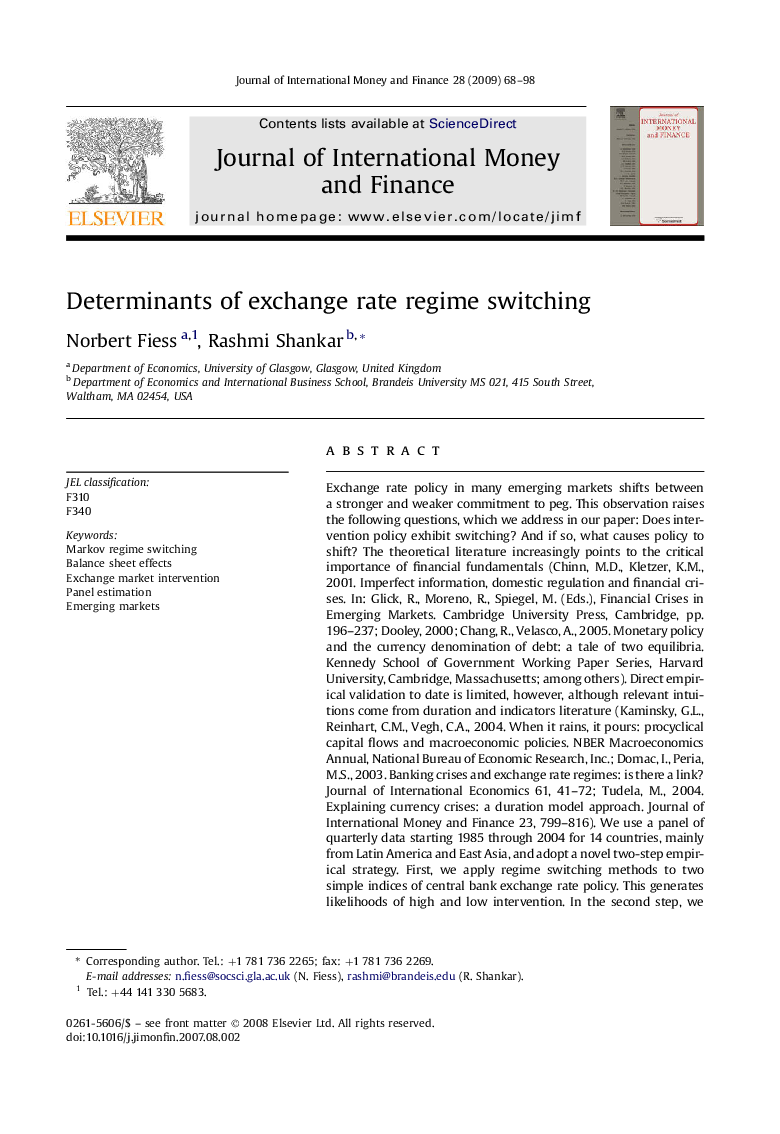| Article ID | Journal | Published Year | Pages | File Type |
|---|---|---|---|---|
| 964402 | Journal of International Money and Finance | 2009 | 31 Pages |
Exchange rate policy in many emerging markets shifts between a stronger and weaker commitment to peg. This observation raises the following questions, which we address in our paper: Does intervention policy exhibit switching? And if so, what causes policy to shift? The theoretical literature increasingly points to the critical importance of financial fundamentals (Chinn, M.D., Kletzer, K.M., 2001. Imperfect information, domestic regulation and financial crises. In: Glick, R., Moreno, R., Spiegel, M. (Eds.), Financial Crises in Emerging Markets. Cambridge University Press, Cambridge, pp. 196–237; Dooley, 2000; Chang, R., Velasco, A., 2005. Monetary policy and the currency denomination of debt: a tale of two equilibria. Kennedy School of Government Working Paper Series, Harvard University, Cambridge, Massachusetts; among others). Direct empirical validation to date is limited, however, although relevant intuitions come from duration and indicators literature (Kaminsky, G.L., Reinhart, C.M., Vegh, C.A., 2004. When it rains, it pours: procyclical capital flows and macroeconomic policies. NBER Macroeconomics Annual, National Bureau of Economic Research, Inc.; Domac, I., Peria, M.S., 2003. Banking crises and exchange rate regimes: is there a link? Journal of International Economics 61, 41–72; Tudela, M., 2004. Explaining currency crises: a duration model approach. Journal of International Money and Finance 23, 799–816). We use a panel of quarterly data starting 1985 through 2004 for 14 countries, mainly from Latin America and East Asia, and adopt a novel two-step empirical strategy. First, we apply regime switching methods to two simple indices of central bank exchange rate policy. This generates likelihoods of high and low intervention. In the second step, we establish the variables that determine these probabilities. We find strong evidence that the economy's balance sheet and economic performance determine the likelihood of switching in the exchange rate regime. Specifically, an increase in reserve currency debt relative to assets raises potential capital losses from devaluation and reduces the probability of switching to a low intervention regime, as does a decline in growth. The purpose here is not to present an alternative regime classification (Levy-Yeyati, E., Sturzenegger, S., 2005. Classifying exchange rate regimes: deeds vs. words. European Economic Review 49, 1603–1635; Reinhart, C.M., Rogoff, K., 2004. The modern history of exchange rate arrangements: a reinterpretation. Quarterly Journal of Economics, Available at: http://www.puaf.umd.edu/faculty/papers/reinhart/papers.htm), but to establish the relative importance of different constraints on the central bank, which has policy implications. The empirical approach and specification is flexible to whether intervention is discrete or gradual and to whether or not the central bank sterilizes.
